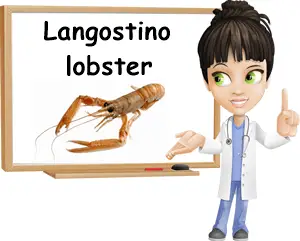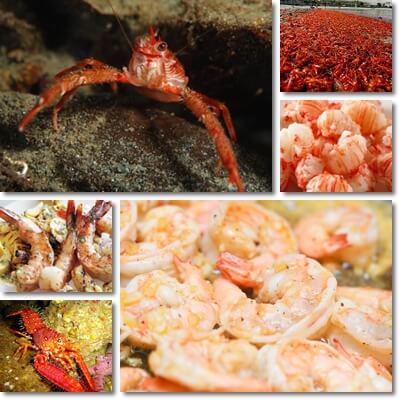Langostino is a common name designating different species of squat lobster. But the term may not refer to the exact same kinds of squat lobster everywhere it’s used. For example, in the US, langostino is used to refer to three species of squat lobster: Pleuroncodes monodon, Cervimunida johni and Munida gregaria. In other parts of the world, if used at all, langostino may refer to entirely different species of squat lobster or other similar-looking crustaceans, even shrimp or prawn. Alternatively, it may be called a galatheid crab, a name referencing its kinship to crabs and the Galatheidae family of squat lobsters.
Langostino, langoustine or langouste?
What is the difference between langostino, langoustine and langouste? Langostino is a term designating three species of squat lobster: Pleuroncodes monodon, Cervimunida johni and Munida gregaria (in the US at least). Langoustine is used to refer to the Nephrops norvegicus species, also called scampi or Norway lobster (see Properties and Benefits of Langoustine). Lastly, langouste is a term denominating spiny or rock lobster species, regionally called crayfish (see Properties and Benefits of Spiny Lobster).

And here are some interesting facts about langostino squat lobsters:
1) There are roughly around 1000 squat lobster species worldwide, but not all are marketed as langostinos.
2) In the US and various other parts of the English-speaking world, langostinos are also commonly called langostino lobsters to identify them with true lobsters such as the American or Maine lobster.
3) Chilean langostinos are identified as Pleuroncodes monodon and Cervimunida johni. The two species are fished off the West coast of Chile, hence their alternative name.
4) Langostino meat can be wild-caught (fished off the West coast of Chile, for example) or sourced from fisheries.
5) Pleuroncodes monodon is known as red squat lobster or red langostino due to its predominantly red shell color. Cervimunida johni is also called yellow langostino.
6) Squat lobsters are marine species and live mostly on the sea bed. They hide into crevices or under rocks and have been observed to gather in large groups.
7) Depending on the species and their size, they may eat anything from plant matter such as algae to microorganisms, larvae or small marine animals, crustaceans included. Because they are scavengers, anything counts as food, whether it’s alive or decaying so their diet is pretty varied.
8) Squat lobster legs can grow to become disproportionately longer than their body length.
9) Their last pair of legs is the smallest and presumably used for cleaning purposes.
What does langostino look like?
The peculiar crustacean looks a bit like crab and lobster. On the one hand, it’s a lot smaller than a true lobster, having up to 8-15 cm in length and weighing a maximum of about 200 g. It has a less bulky body, looking more like a crab at first glance. But it does have a thick, rounded-triangular bright red or brown shell, although although less resilient compared to that of true lobsters. The small crustacean has 10 legs just like lobsters and crabs. Similar to true lobsters, the front pair of legs is visibly larger, each leg ending in a claw to help the langostino defend itself, catch prey and feed. Furthermore, the body is segmented and the tail ends in a fan. The langostino keeps its fan-shaped tail is kept hidden underneath its chest cavity, as if it’s squatting, a peculiarity that is presumed to have been the source of the name ‘squat lobster’.

What does langostino meat taste like?
In the US, langostino meat comes primarily from three squat lobster species scientifically known as Pleuroncodes monodon, Cervimunida johni and Munida gregaria. Although the slightly less accessible claw meat can be consumed as well, the fan-shaped tail is the main source of meat and is sometimes marketed under the name ‘Chilean langostino tails’. This is a common name that is used to refer to the P. monodon and C. johni species fished off the West coast of Chile.
The tail meat is soft, delicate and tastes pleasant, quite similar to true lobster or shrimp. Unless a connoisseur of fine seafood, it is not always easy to tell them apart. The meat is translucent white and can have a reddish tinge from astaxanthin, a carotenoid pigment giving the shell its red-orange color. The pigment is also responsible for the red color of various algae species and salmon. You can find whole langostino or shelled tail meat for sale in supermarkets, food stores specialized in seafood or at the fish market, depending on where you live. You can use the meat as a substitute for Maine lobster or shrimp in dishes.
Nutrition facts and health benefits
1) Langostino tail meat is high-protein and is good for building muscle.
2) Extremely low-fat, low-carb as well as low in calories – good food to eat for healthy weight loss.
3) Like other crustaceans, the meat is a source of EPA and DHA Omega-3 fatty acids for brain nutrition.
4) Potential benefits for anxiety and depression from Omega-3 fatty acids.
5) Both protein and Omega-3 fatty acids combat brain fog and support memory and learning.
6) Omega-3 fatty acids increase HDL (good) cholesterol levels for better HDL-LDL cholesterol ratio.
7) Omega-3 fatty acids in langostino tail meat further exert anti-inflammatory properties with benefits for the cardiovascular system.
8) Good for fertility – the higher cholesterol content helps with hormone production.
9) The cholesterol, Omega-3 fatty acids and vitamin B12 in langostino meat protect against early cognitive decline and degenerative diseases of the nervous system.
10) Source of iodine and selenium, langostino supports thyroid function with direct benefits for metabolism and fertility.
11) High amounts of vitamin B12 and iron combat tiredness, fatigue and muscle weakness associated with anemia and restore vitality.
12) Good amounts of vitamin B3 for skin and nervous system health.
13) Contains good amounts of magnesium and potassium for healthy blood pressure numbers.
Higher in sodium, can encourage high blood pressure if eaten in excess (and over-salted).
14) B vitamins combat dry, cracked skin, while vitamin E and Omega-3 have anti-inflammatory and antioxidant properties and help skin better retain moisture for a healthier, younger appearance.
15) Langostino is high in phosphorus and a moderate source of calcium and magnesium for strong bones and teeth.
16) Potential benefits for pregnant women from iodine, Omega-3, vitamin B12 and iron.
Side effects and contraindications
1) Food-related illness. Eating uncooked or undercooked seafood of any kind, whether langostino or squat lobster or another kind, is contraindicated because it holds a risk for food-related illness (gastroenteritis, worms and intestinal parasites infections). Some categories of people such as small children, the elderly, pregnant women and anyone with immune system deficiencies are more at risk for complications from food-related illnesses and should avoid raw or undercooked seafood.
2) Langostino and pregnancy contraindications. Seafood is sometimes a contraindication for pregnant women because of the risk of heavy metal contamination. While crab and lobster and squat lobster too are naturally low in mercury or other contaminants, pollution of their habitat can cause mercury levels to raise and pose risks for pregnant women in particular. Mercury is known to affect the nervous system and can potentially cause developmental problems in babies. Also, the higher sodium content may cause or accentuate hypertension if langostino consumption is excessive.
Other than this, the particular nutrition of langostino tail meat favors normal baby development during pregnancy. Iodine, Omega-3 fatty acids, vitamins B9 and B12 support normal brain and nervous system development of the baby in the womb and prevent neural tube defects of the brain, spine and spinal cord such as spina bifida. Vitamins B9, B12 and iron further promote elevated energy levels and restore vitality.
3) Allergic reaction. A major side effect of crustaceans and most seafood is their potential to cause allergic reactions that could culminate in anaphylactic shock (which is a medical emergency). If you know or even suspect an allergy to langostino or any crab, lobster, shrimp or prawn species, refrain from consumption. Avoid the (potential) allergen in all forms and preparations.
4) Cardiovascular side effects. All seafood is naturally high in sodium which makes its regular consumption contraindicated in cardiovascular disease. If you have high blood pressure, refrain from eating excessive amounts of the crustacean and choose low-salt or salt-free preparation options. As for the higher cholesterol content, it does not negatively impact blood cholesterol levels. On the contrary, the EPA and DHA Omega-3 fatty acids help raise the good kind of cholesterol, HDL, contributing to better overall cardiovascular health.
